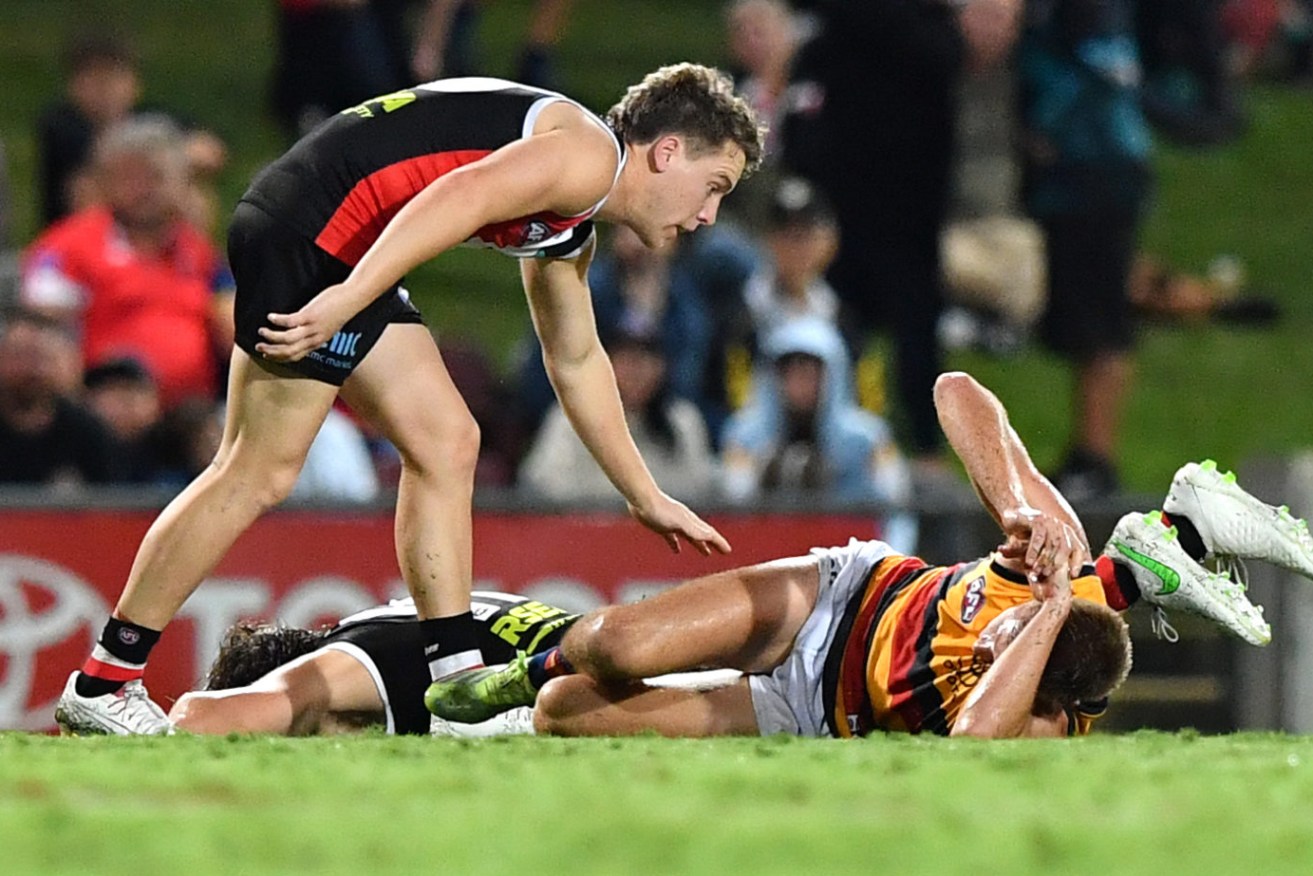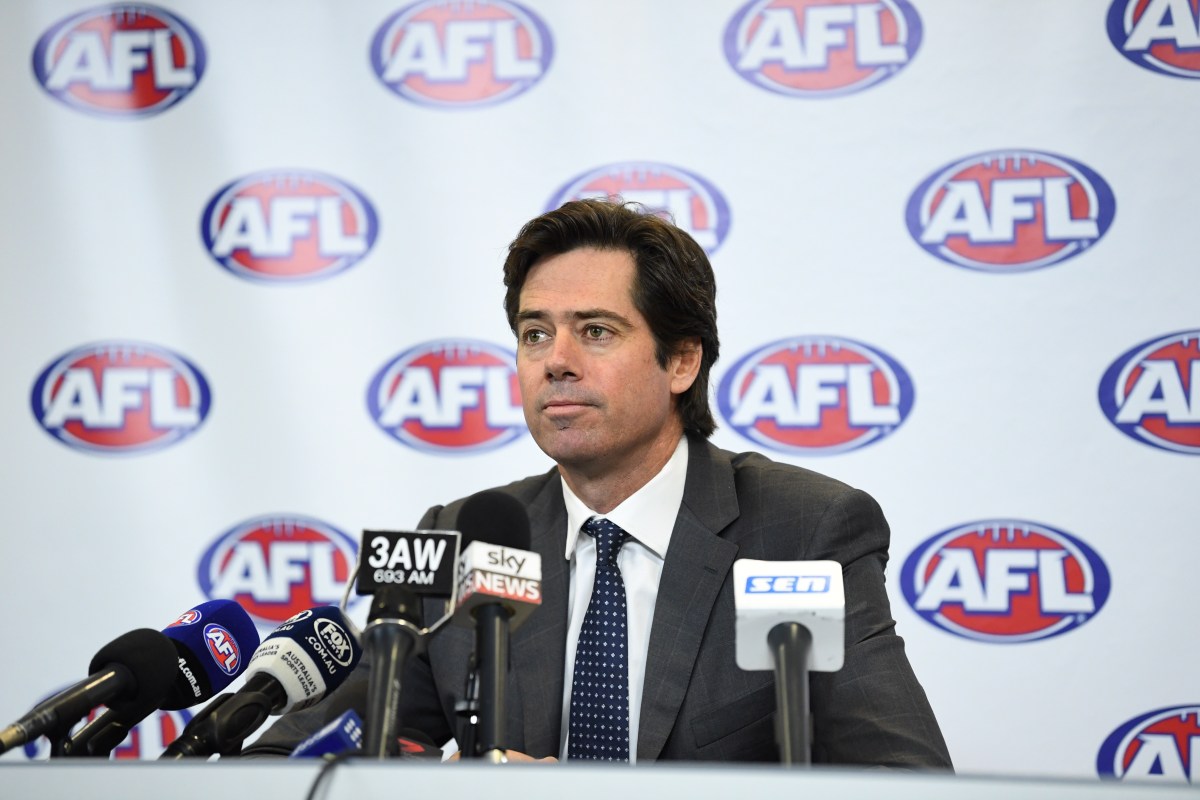Bump and grind: AFL’s campaign to reduce player injury
The high-profile tribunal hearing over Crow David Mackay’s collision with another player demonstrated the AFL’s intent to minimise serious head injuries. Michelangelo Rucci examines how and why it will change the game.

St Kilda's Jack Lonie checks on injured team mate Hunter Clark (centre) and David Mackay after their collision. Photo: AAP/Darren England
Byron Pickett and David Mackay. These are two names that do not instantly link themselves by the way each AFL footballer plays the game.
But the pair will be forever remembered as the men who gave concerned AFL executives the tribunal cases to start and finish a two-decade campaign to minimise serious head injuries (not just concussion) in Australian football.
Pickett, the Norm Smith Medallist as best-afield during the 2004 AFL grand final, was a cult figure among Port Adelaide fans and a torment to opposition players for his wrecking-ball approach, in particular with his typhoon-like bumps.
Pickett became the AFL’s test case for a new tribunal system and a new theme towards player safety in March 2005. He was banned for six matches for his “hip-and-shoulder bump that went wrong” to concuss Crows utility James Begley in a pre-season derby at Football Park.
The AFL took this tribunal victory as a mandate to rewrite the rules forbidding front-on contact to an opponent and minimise, as then AFL football chief Adrian Anderson told InDaily this week, “catastrophic spinal injury”.
Port Adelaide premiership coach Mark Williams’ declared the AFL had made Pickett “unemployable” as a league footballer, and later campaigned for rules to protect players from head injuries.
Mackay, the so-called “whipping boy” of Crows fans, became the burning focus of Australian football last week when current AFL football boss Steve Hocking sent him to the AFL tribunal to answer for the collision (or bump) in Cairns that left St Kilda midfielder Hunter Clarke with a broken jaw.
Mackay, unlike Pickett, was cleared of any wrongdoing by a three-man jury of former league footballers (Richard Loveridge, Paul Williams and David Neitz) after Hocking had sought a penalty of at least three matches.
Does it end here?
No. Hocking insists he will file a tribunal notice if there is a similar incident – and he will rewrite the rules if the tribunal keeps rejecting his charges.
“The health and safety of players at all levels of the game remains paramount and the AFL will not hesitate to take action where the health and safety of players is impacted or at risk,” Hocking said.
“If necessary, rules will be adjusted at the end of the season. We make no apologies for taking action to make the game safer for participants at all levels of the game.”
The message is clear: Australian football is walking away away from the image of a brutal, combative sport where players take heavy hits without protection from pads or helmets.
Hocking, a former Geelong player whose 199 AFL games include the 1989 grand final against Hawthorn, will find that protection – with new rules.
“Players must take reasonable care at all times, including how they approach a contest and how they bump an opponent and they need to continue to do so in the future,” Hocking warns. “There is an ongoing process and review of the rules to protect the health and safety of all players in the game.”
From the fall-out of the Mackay tribunal case, InDaily spoke to former and current league executives, players and lawyers to understand how and why Hocking is on this path to changing Australian football.
Greg Griffin is a prominent Adelaide lawyer fighting the AFL on the vexing concussion debate. While Mackay was preparing for his tribunal hearing last week, Griffin was ushering former AFL players with medical records of repetitive concussions to Adelaide Oval to consult with Sydney neurologist Dr Rowena Mobbs.
The general impression that Hocking needs to end head injuries in Australian football to avert these being added to the class-action concussion cases compiled by Griffin and colleague Peter Jess in Melbourne is contradicted by Griffin. He applauds the AFL tribunal for clearing Mackay.
“That was two players going for the same ball, touching the same ball, colliding at the same time,” Griffin said. “Had they suspended Mackay, it would have been a disgrace.”

Greg Griffin. Photo: Nat Rogers / InDaily
Griffin’s case against the AFL is based on what is happening off the field with player care after players are concussed, including the current 12-day rest enforced by the league’s new concussion protocols today.
“Those 12 days are two days’ off two weeks, so any concussed players will always miss one game – not two,” Griffin said. “In my view (the protocol) is just another device to give the impression that the AFL is doing the right thing when in reality they are not.”
If necessary, rules will be adjusted at the end of the season. We make no apologies for taking action to make the game safer for participants at all levels of the game.
Adrian Anderson was AFL football chief from February 2004 to the end of 2012. He started the league’s refit of the tribunal and rule book and it was medical advice – not a fear of expensive legal settlements – that prompted a new approach to player safety.
“Our concern,” Anderson told InDaily this week, “our No.1 intent was to protect the players. Player safety was paramount, and that message came from our medical officers, Henry Unglik and Hugh Seward,” he said.
“We had to make the game safer to play. The doctors’ number one concern was catastrophic spinal injuries (by front-on bumps to the head), and number two was head injuries.
“I appreciate that concern more now that I am a father of three boys who play football. And it is more and more concerning when you see kids pushing opponents headfirst to ground to win holding-the-ball free kicks. We have to make the game safe for kids to play.
“That certainly was our message when we acted in 2005 after seeing Byron Pickett bump James Begley when James had his head over the ball,” added Anderson of the incident that virtually ended Begley’s professional football career and started a long torment with concussion.
Anderson endorses the AFL tribunal call on Mackay.
“Right decision … under the current rules,” said Anderson, who has returned to his legal roots as a barrister in Melbourne after following up his AFL work at Cricket Australia and Cycling Australia.
Hocking’s vow to review the rules – to deliver a different tribunal result – leaves the AFL with two options, according to Anderson.
“One way to rewrite the rules is to declare if you are without the ball and you make forceful head-high contact to an opponent, you will be deemed as careless and held to account for the consequences of your actions,” he said.
“This would protect the head. Players would be forced to adjust. And there will be some unfair outcomes at the tribunal (with pure football collisions such as the Mackay clash with Clark).
“The second option is you call an end to the bump with the shoulder, in the same way rugby league has rewritten its rules to protect players.”
Daniel Talia, the 200-game All-Australian defender at the Adelaide Football Club, finds the prospect of being judged at the AFL tribunal by consequences rather than actions or intent as confronting.
“That is the frustrating part,” he said. “You can’t control that when you go for the ball in a 50-50 contest. If the guy enters that contest with the right intentions and there is an injury, he should not be penalised.
“It is a tough debate. I understand the issue on the health and safety of players and the need to protect players, but this is a tough one.”
Mackay made the same point on leaving his lengthy tribunal hearing last week saying: “I am completely behind the AFL’s quest to make the game safer and protect the head and neck and it’s our responsibility to make the game as safe as possible, but there are times when accidents do happen; it’s the nature of the game and the way it’s played.”
Anderson describes the rule changes looming on Hocking’s agenda as a “big step” for the AFL.
“The game would be outlawing all – even accidental – contact to the head,” Anderson said. “Even if you are going for the ball (as Mackay was in the Clark case), you can’t make head-high contact.
“For such a rule to work, players would have to adjust their behaviours and if they don’t, they would face suspensions. There could be some unfair outcomes at the tribunal.”
Anderson’s expectation for current-day players to adapt is backed up by the remarks of former Crows defender and ex-Greater Western Sydney captain Phil Davis.
“Tell me and I will change,” he said. “If you don’t want (head-high injuries) that’s fine, tell me, change the rules and say, ‘If you do this, you will be suspended’. But I just need to know what the rules are and what the standards are and then I will adapt my game.”
The fans might struggle, however.
Their outcry, as noted during the Mackay case, would be based on the emotive theme that the AFL would be “changing the fabric” of Australian football.
Gillon McLachlan, AFL chief executive since 2014, rejects the suggestion Hocking’s mission to protect players from head-high injuries will deliver a “softer” sport that defies the traditional combative and physical nature of Australian football.

AFL CEO Gillon McLachlan. Photo: AAP/James Ross
McLachlan has a clear mantra today – “protect the head” – that he repeats as a catchphrase.
“I don’t think our game is any less tough,” he said. “It’s as physical as it’s ever been, but it can be a physical game that still protects the head.
“There is still such a role for toughness and bravery in our game, but we can do it in a way where we do everything we can to protect the head.
“That’s certainly our aim. If people think that’s changing the fabric, then I think it’s in a good way, because we need to protect the head.
“We’ll continue to protect the head and that’s had pushback from lots of quarters. The game will continue to make decisions to protect the head.”
David King was one of the toughest and most uncompromising players while he won two AFL premierships in a 241-game career at North Melbourne. He was among the first to demand action from the AFL to make the game safer. Upon hearing McLachlan and Hocking’s words, he feels this will happen.
“Players (need to) accept that there’s a shift (against head-high contact),” King said. “It may not be legislated, it may not be in print just yet, but I think we will get there.
“It might be three years, might be five years, but we’ll get there because the cost is too significant.
“I’m looking at the health and wellbeing of players long-term. We’ve got so many players on the sidelines with their lives being altered at 21-22 years of age. They’ve got 80 years of their lives to come.”
King’s point is made in reflecting on how Begley’s football career ended and the difficulties he had from the concussion suffered from the Pickett bump.
The claims that “the bump is dead” and Australian football was going soft were loud after Pickett was suspended for six matches, but this fear of a softened game has never held up. The bump stayed, even after the rules were rewritten to ban front-on bumps. More players have faced the consequences of their actions from the AFL match review officer Michael Christian or the tribunal, while the bump has lived on.
Mackay has put accidental head injuries from collisions firmly on the league’s agenda. Clearly new rules will come from Hocking’s desk.
“Players will be deemed careless (for head-high injuries) and we will have a game that does more to protect the players,” Anderson notes. “There also could be some unfair outcomes at the tribunal. Players would adjust.”
But how will the fans adjust while watching their team’s players sitting in the grandstands, serving a tribunal suspension, for being part of an accidental moment on the football field?
This is the price for a “safer” game of Australian football.




